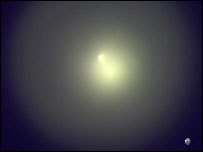
|
| ©n/a |
| The earth in relation to the comet is 244 million km (151 614 570 miles) away |
Professor Tim Naylor from Exeter University saw Holmes Comet using the Isaac Newton Telescope at La Palma.
Professor Naylor said: "Comets are not normally my thing, so it was a challenge to observe something so bright with a large telescope."
The comet has brightened by a factor of a million and can now be seen across the UK with the naked eye.
Fuzzy object
On Monday the comet was a very faint object that needed a large telescope to see it, then on Tuesday night, Professor Naylor saw it suddenly become much brighter.
The comet is seen as a small fuzzy object as bright as a medium-brightness star in the constellation Perseus and can be viewed for the next few weeks.
Back in Exeter the professor said: "I walk out in to my back garden and my eight year old can see it.
"The best time is early evening before the moon comes up."
Astronomers believe a build-up of gas under part of the surface has ruptured it making it appear brighter but they are still studying it to find out the cause.



Reader Comments
to our Newsletter